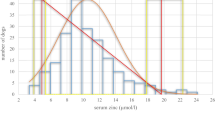Abstract
This study validates an automated enzymatic assay using the Cobas Fara (Roche) centrifugal analyser, which offers a reliable measurement of the total sialic acid concentration in canine serum as assessed by evaluating the precision and accuracy. Data are presented on the biological variation in the total serum sialic acid concentration. Measurements of total serum sialic acid concentration appear to be useful in distinguishing dogs with neoplastic disorders from clinically healthy dogs.
Similar content being viewed by others
Abbreviations
- AcNeu:
-
N-acetylneuraminic acid
- CV%:
-
coefficient of variation
- LASA:
-
lipid-associated sialic acid
- S 2 :
-
component of variance
References
Allen, S.W., Prasse, K.W. and Mahaffey, E.A., 1986. Cytologic differentiation of benign from malignant canine mammary tumors.Veterinary Pathology,23, 649–655
Armitage, P. and Berry, G., 1987. Statistical interference. In: P. Armitage and G. Berry (eds.),Statistical Methods in Medical Research, 2nd edn., (Blackwell Scientific Publications, Oxford), 93–140
Crook, M., 1993. The determination of plasma or serum sialic acid.Clinical Biochemistry,26, 31–38
Fayolle, P., Broulet, V., Braun, J.P., Rico, A.G., Magnol, J.P. and Thouvenot, J.P., 1987. Routine hematology and clinical chemistry in female dogs with benign and malignant mammary tumors.Veterinary Clinical Pathology,16, 73–75
Fraser, C.G., 1983. Desirable performance standards for clinical chemistry tests.Advances in Clinical Chemistry,23, 299–339
Fraser, C.G. and Harris, E.G., 1989. Generation and application of data on biological variation in clinical chemistry.CRC Critical Review of Clinical Laboratory Science,27, 409–430
Freund, R.J. and Littell, R.C., 1991. A three-factor response surface experiment. In: J. Lopez, P.R. Sheldon and K. Whatley (eds.),SAS System for Regression, 2nd edn, (SAS Institute Inc., Cary), 143–150
Horiuchi, T. and Kurokawa, T., 1989. New enzymatic endpoint assay of serum sialic acid.Clinica Chimica Acta,182, 117–122
Jensen, A.L. and Aaes, H., 1992. Reference interval and critical difference for canine serum fructosamine concentration.Veterinary Research Communications,16, 317–325
Kloppel, T.M., Franz, C.P., Morré, D.J. and Richardson, R.C., 1978. Serum sialic acid levels increased in tumor-bearing dogs.American Journal of Veterinary Research,39, 1377–1380
Ménard, M., Fontaine, M. and Morin, M., 1986. Fine needle aspiration biopsy of malignant tumors in dogs and cats: A report of 102 cases.Canadian Veterinary Journal,27, 504–510
Plucinsky, M.C., Riley, W.M., Prorok, J.J. and Alhadeff, J.A., 1986. Total and lipid-associated serum sialic acid levels in cancer patients with different primary sites and differing degrees of metastatic involvement.Cancer,58, 2680–2685
Poli, A., Arispici, M., Camillo, F. and Corazza, M., 1986. Increase of serum lipid-associated sialic acid concentration in dogs with neoplasms.American Journal of Veterinary Research,47, 607–609
Shamberger, R.J., 1986. Evaluation of water soluble and lipid soluble sialic acid levels as tumor markers.Anticancer Research,6, 717–720
Stefenelli, N., Klotz, H., Engel, A. and Bauer, P., 1985. Serum sialic acid in malignant tumors, bacterial infections, and chronic liver diseases.Journal of Cancer Research and Clinical Oncology,109, 55–59
Sugahara, K., Sugimoto, K., Nomura, O. and Usui, T., 1980. Enzymatic assay of serum sialic acid.Clinica Chimica Acta,108, 493–498
Végh, Zs., Kremmer, T., Boldizsar, M., Gesztesi, K.A. and Szajani, B., 1991. A re-evaluation of the lipid-bound sialic acid determination.Clinical Chimica Acta,203, 259–268
Voigtmann, R., Pokorny, J. and Meinshausen, A., 1989. Evaluation and limitations of the lipid-associated sialic acid test for the detection of cancer.Cancer,64, 2279–2283
Warren, L., Fuhrer, J.P. and Buck, C.A., 1972. Surface glycoproteins of normal and transformed cells: A difference determined by sialic acid and a growth-dependent sialyl transferase.Proceedings of the National Academy of the USA,7, 1838–1842
Waters, P.J., Lewry, E. and Pennock, C.A., 1992. Measurement of sialic acid in serum and urine: clinical applications and limitations.Annals of Clinical Biochemistry,29, 625–637
Weisberg, S., 1985.Applied Linear Regression, 2nd edn, (Wiley, New York)
Yogeeswaran, G., 1983. Cell surface glycolipids and glycoproteins in malignant transformation.Advances in Cancer Research,38, 289–350
Author information
Authors and Affiliations
Rights and permissions
About this article
Cite this article
Thougaard, A.V., Jensen, A.L. & Wenck, A. Evaluation of an automated spectrophotometric assay for the determination of total sialic acid in canine serum. Vet Res Commun 18, 337–345 (1994). https://doi.org/10.1007/BF01839284
Accepted:
Issue Date:
DOI: https://doi.org/10.1007/BF01839284



